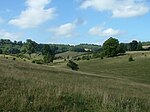Hawridge Windmill
Grade II listed buildings in BuckinghamshireGrade II listed windmillsGrinding mills in the United KingdomSmock mills in EnglandTower mills in the United Kingdom ... and 3 more
Use British English from February 2023Windmills completed in 1883Windmills in Buckinghamshire

Hawridge Windmill which is also known as Cholesbury Windmill is a disused tower mill in Hawridge, Buckinghamshire. The mill was constructed on the site of an earlier smock mill and became a private residence in 1913 when the first occupier, the writer Gilbert Cannan used it as a studio.
Excerpt from the Wikipedia article Hawridge Windmill (License: CC BY-SA 3.0, Authors, Images).Hawridge Windmill
Ray's Hill,
Geographical coordinates (GPS) Address Nearby Places Show on map
Geographical coordinates (GPS)
| Latitude | Longitude |
|---|---|
| N 51.753333333333 ° | E -0.6475 ° |
Address
Ray's Hill
Ray's Hill
HP5 2UJ , Cholesbury-cum-St Leonards (Chesham and Villages Community Board)
England, United Kingdom
Open on Google Maps










